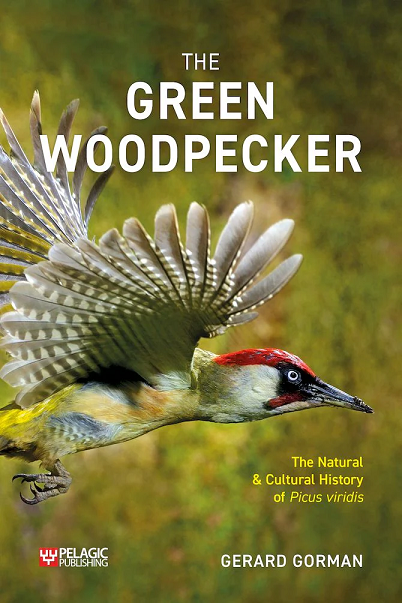
I like Green Woodpeckers, I always have, and was keen to find out more about them from the pen (keyboard I guess) of an acknowledged world woodpecker expert (see here for a review of the same author’s Wryneck).
The book comprises 17 chapters which run from the taxonomy of the species through its anatomy, morphology, moult, behaviour, population levels and distribution across its whole world (primarily European) range, conservation and its place in folklore and mythology. If you want to know what we currently know about this species then this, undoubtedly, is the book for you. The next time a Green Woodpecker flies up close to you, surprising you with the brightness of its yellow rump, then you’ll know a lot more about what you are looking at.
Cats and cold winters seem to be the main dangers faced by this species so it’s not surprising that the longevity record for the species (known from ringing data) is 15 years (and from the UK). But that got me wondering about how many Green Woodpeckers are ringed in the UK and Ireland each year – it’s around 200, of which some are retrapped but very few are recovered. I expect there are some pretty ancient Green Woodpeckers out there. They don’t seem to move much either – most recoveries are very close to where the birds, mostly juveniles, were ringed. So this is a fairly long-lived bird that doesn’t move very far. I’d have thought this species was a good candidate for having helpers at the nest where young from previous years help raise future broods, but there is no indication of that being a feature of this species. So maybe young birds are always forced out of the parents’ territory (there are descriptions of that type of behaviour here) and struggle to find their own territories in which to live. There is much more to be discovered about this species, I feel.
Perhaps not surprisingly, this striking bird (the fine photographs in the text remind one of what a stunning bird this is) with its easily recognised far-carrying yaffling call is a subject of myths and legends, but I was interested to know that these go well past country folk in the Middle Ages, and back past the Romans, and past the Greeks, to at least the Babylonian empire of 4000 years ago. The next time I hear or see a Green Woodpecker at my local patch of Stanwick Lakes (which is likely to on my next visit) I’ll give a thought to ancient Mesopotamia and the goddess the Axe of Ishtar who was represented as a green-coloured woodpecker. And I’ll hope to see a woodpecker flying from left to right because that is a good omen whereas one flying from right to left is no omen at all.
This book appears to be a thorough compendium of what we know about this species and I enjoyed reading it. It also whetted my appetite to know more – maybe you can go out and add to our knowledge of this familiar, widespread and attractive bird.
The cover? Yes, that’s the cover for a book about Green Woodpeckers! I’d give it 9/10.
The Green Woodpecker: the natural and cultural history of Picus viridis by Gerard Gorman is published by Pelagic Publishing.

My forthcoming book, Reflections, will be published on 4 July.
Details – click here and read what others think about it.
[registration_form]